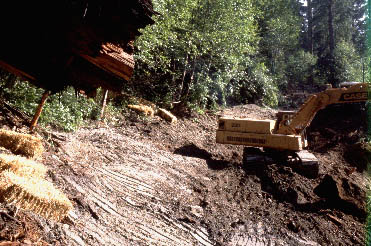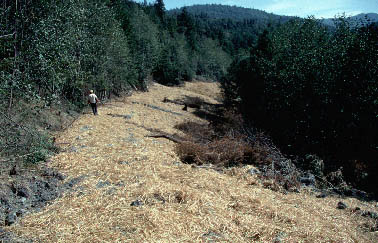Bibliography Background About KRIS
Watershed Restoration
Erosion Control/Road Decommissioning
Work in Redwood National Park (RNP) began to trace the source of sediment to erosional mechanisms operating on hillslopes (Hagans et al., 1986). The major source of sediment was found to be roads, particularly stream capture at road crossings (when the stream begins to flow down the road) and failure of the crossings themselves. In the early 1990s, erosion prevention began to be widely implemented in the Park but the approach in areas outside RNP were more strategic, with an emphasis on cost-effective measures to target areas of highest sediment production. (Pacific Watershed Associates, 1994).
 |
 |
|---|---|
| When roads are decommissioned, they first are reshaped to the original contours of the hillslope. | Mulching helps prevent erosion until new vegetation get established. |
In the Nooksack River basin in Washington State, Harr and Nichols (1993) showed that road failures and sediment yield can be substantially reduced if road storm proofing and decommissioning are carried out. They found that prior to treatment, sediment yield from roads was 110 times that from undisturbed forests and six times greater than from lands destabilized by timber harvest. After treating all the roads in the Canyon Creek sub-basin, only one landslide occurred as a result of 50 year recurrence interval storms in 1989 and 1990, whereas 17 road related landslides had occurred in 2 to 5 year interval storms in years prior to erosion prevention work. The authors pointed out that previous road-related slides during even moderate storm events had contributed 191,000 cubic meters of sediment to Canyon Creek and that the erosion control project had likely prevented substantial yields in 1989-90.
Money recently allocated by the California Legislature (SB 271) is now going more toward road upgrading and decommissioning than toward instream work. While this shift in emphasis is warranted, there is still a potential for State and Federal efforts to control stream pollution to be confounded. Even if roads are stabilized and crossings upgraded, many miles of road per square mile of watershed area may remain. Cedarholm et al, (1981) found that road densities of greater than three miles per square mile were likely to contribute levels of fine sediment to streams that were harmful to salmon and steelhead eggs and alevin. If road densities are not decreased overall, the potential still exists for high chronic surface erosion and catastrophic failure of culverts during major storm events. A recent restoration planning document for the Salmon River by the Klamath National Forest (Elder at al., 2000) suggests that the maximum road densities in that basin should not exceed 2.5 miles/square mile.
Protecting Refugia
The new cornerstone of salmon restoration ecology is that protection of the last patches of functional habitat or "refugia" is paramount (FEMAT, 1993; Bradbury et al., 1995). Restoration of salmon and steelhead populations will only be possible if gene resources are protected and some viable habitat patches remain to provide a source of colonists for those habitat areas recovered in the future (Sedell et al., 1990). Protecting the last patches of functional habitat for Pacific salmon is also prudent because our ability to restore habitats remains in question. Kauffman et al. (1997) noted that: "Because the failure rate of restoring degraded ecosystems is far greater than that of simply protecting fully functional sites, protecting and preserving intact ecosystems should represent the first priority of any watershed-scale restoration plan."
Watershed Rest
Kauffmann et al. (1997) state that "Once professionals have decided where to implement restoration activities, the first and most critical step is to halt activities causing degradation or preventing recovery, an approach referred to as passive or natural restoration." Reeves et al. (1993) pointed out that watersheds with greater than 25% disturbance due to timber harvest on the Oregon coast had compromised habitat diversity and supported only monotypic communities of salmonids. This suggests that watersheds with greater than 25% disturbance need a period of rest from watershed management activity in order to allow slope stabilization, riparian recovery and decreased risk of increased peak flows during major storm events. Burns (1972) recommended that watersheds be rested in his study of logging impacts in northwestern California: "Sustained logging and associated road construction over a number of years do not afford either the stream or fish population a chance to recover....Logging operations should be concluded in the shortest time possible and then the watershed left to recover."
References
Bradbury, W., W. Nehlsen, T. Nickleson, K. Moore, R. Hughes, D. Heller, J. Nicholas, D. Bottom, W. Weaver, R. Beschta. 1995 . Handbook for Prioritizing Watershed Protection and Restoration to Aid Recovery of Native Salmon. Published by Pacific Rivers Council, Eugene, OR. 47 p.
Burns, J.W. 1972. Some effects of logging and associated road construction on northern California streams. Transactions of the American Fisheries Society. Vol. 101: 1-17.
Cedarholm, C.J., L.M. Reid and E.O. Salo. 1981. Cumulative effects of logging road sediment on salmonid populations of the Clearwater River, Jefferson County, Washington. Pages 38-74 in Proceedings of Conference on Salmon Spawning Gravel: A Renewable Resource in the Pacific Northwest? Report 19. Wash. State University, Water Research Center, Pullman, WA.
Elder, D., B. Olson, A. Olson, J. Villeponteaux, P. Brucker. 2000. Salmon River Subbasin Restoration Strategy: Steps to Recovery and Conservation of Aquatic Resources. Klamath National Forest, Yreka, California.
FEMAT. 1993. Forest Ecosystem Management: An Ecological, Economic and Social Assessment. USDA Forest Service, BLM, USFWS, NOAA, EPA and National Park Service. Portland, Oregon.
Hagans, D.K., W.E. Weaverand M.A. Madej.1986. Long term onsite and offsite effects of logging and erosion in the Redwood Creek basin, Northern California. In: Papers presented at the American Geophysical Union meeting on cumulative effects (1985 December); National Council on Air and Streams, Tech.Bull.No. 490, pp.38-66
Harr, R.D. and R.A. Nichols, 1993 , Stabilizing forest roads to help restore fish habitats: a northwest Washington example. Fisheries, Vol. 18, No. 4, pages 18-22.
Kauffman, J.B., R.L. Beschta, N. Otting, and D. Lytjen. 1997 . An Ecological Perspective of Riparian and Stream Restoration in the Western United States. Fisheries 22(5):12-24.
Pacific Watershed Associates. 1994. Action plan for the restoration of the South Fork Trinity River watershed and its fisheries. Prepared for U.S. Bureau of Reclamation and the Trinity River Task Force, Contract No. 2-CS-20-01100.
Reeves, G.H., F.H. Everest, and J.R. Sedell. 1993. Diversity of Juvenile Anadromous Salmonid Assemblages in Coastal Oregon Basins with Different Levels of Timber Harvest. Transactions of the American Fisheries Society. 122(3): 309-317.
Sedell, J.R., G.H. Reeves, F.R. Hauer, J.A. Stanford, and C.P. Hawkins. 1990. Role of Refugia in Recovery from Disturbances: Modern Fragmented and Disconnected River Systems. Environmental Management. Vol 14, No. 5, pp 711-724.
